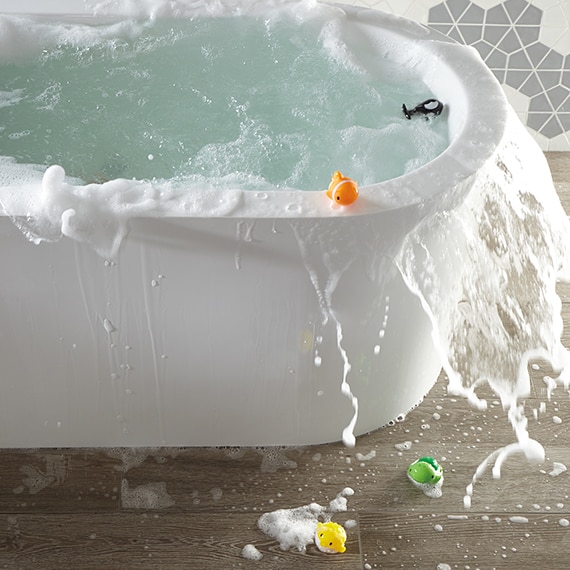
WHAT IS DCOF?

putting safety first
DCOF Recommended Applications
Daltile recommends that the following guidelines shall be utilized together with a regular cleaning / maintenance program.
Information in italics correspond to relevant ANSI A326.3 Section 4 - “Product Use Categories”
| Product Use Classification | Example Area | DCOF per ANSI A326.3 |
|
Dry & Level Interior
Interior Dry (ID) |
Level public areas that are DRY and contaminant free. Some examples are (but not limited to): hotel lobbies, apartments, public buildings, shopping centers (excluding food areas), hospitals, elevator lobbies, interior hallways, cafeterias, retail stores, theatre lobbies and other dry health service areas. | ≥ 0.42 Dry |
|
Wet & Level Interior
Interior Wet (IW) |
Level public areas that are likely to be walked on when WET. Some examples are (but not limited to): Entry foyers of hotels, offices and other public buildings, supermarkets (entry areas, food preparation, produce, or any area where water may occasionally be present), shopping center food courts, and toilet facilities, and production areas not involving oil or fats. | ≥ 0.42 Wet |
|
Exterior Applications
Exterior Wet (EW) |
Level Pedestrian areas that could be exposed to water (excluding ice), but are otherwise reasonably maintained, where footwear is typically used. Some examples are (but not limited to): walkways, gazebos, or patio areas. | ≥ 0.60 Wet |
|
Pool Decking (and other wet areas with minimal footwear)
Interior Wet+ (IW+) |
Level Service or recreation areas involving constant water where light or no footwear is used. Some examples are (but not limited to): public showers, steam rooms, swimming pool decks, and locker rooms. | ≥ 0.60 Wet |
|
Oils
Oils / Greases (O/G) |
Level Service or production areas involving oils, greases, and/or fats. Some examples are (but not limited to): automotive fluids, catering areas, areas involving deep-fry and grill equipment, other food preparation areas involving grease or oil. BOH (Back of the house) quick service or family style restaurants or delicatessens. Any area where combined grease and water accumulation may be present. Daltile recommends Quarry tile and treaded paver products for this application. | ≥ 0.60 Wet |
| Ramps & Inclines | Inclined areas or ADA compliant ramps. Some examples are (but not limited to): Stairs and stair treads/nosings, wheelchair ramps, workshop bays (where no oil is present), sidewalks, and driveways where pedestrian traffic is normally present./td> | ≥ 0.65 Wet |
Additional considerations relating to product selection:
1. Absent exceptions listed on this page indicating otherwise, ceramic and porcelain tiles should not be used in floor applications where there is a consistent surface presence of water, oil, or grease. This includes outdoor areas.
2. Proper maintenance is critical. Improper maintenance and improper maintenance products can result in a build-up on the surface of the tile causing the tile to be slippery. See maintenance recommendations.
3. Test Methods - there are many different test methods related to slip resistance. Daltile recommends that customers have tile independently tested to determine if the Daltile product meets the requirements of the customer's preferred test method. Daltile and the tile industry recognize ANSI A326.3 - American National Standard Test Method for Measuring Dynamic Coefficient of Friction of Hard Surface Flooring Materials. Daltile does not warrant that any of its products will meet any testing parameter other than that measured per ANSI A326.3.
4. ANSI A137.1 requires that tiles suitable for interior level spaces expected to be walked upon when wet have a minimum, wet DCOF of 0.42.
5. No floor tile is "slip proof."
6. Slippery conditions can be reduced by limiting foot traffic in contaminated conditions, use of appropriate footwear, prompt removal of contaminants, effective drainage, and proper maintenance. Installations and end use conditions can vary. The end user must evaluate the tile to be used with their specific end use conditions, maintenance program(s), and footwear selection to determine compatibility.
7. Tile size can be a factor for slip resistance in wet areas. Smaller sizes allow for more drainage through an increased number of grout joints and easier sloping. Planar variations on larger formats could result in a higher probability of standing water and increase the risk for hydroplaning.
8. Polished and semi polished surfaces create a very smooth surface. Daltile does not recommend polished surfaces in any areas that may be subjected to water, oil, or grease exposures.
9. Internal manufacturer selection criteria can for example, but not in limitation, be based on factors such as: DCOF limit values established using the ANSI A326.3 test method, limit values based on other test methods, internal reference standards and practices, presence of abrasive grain, presence of surface structure and/or experience with similar surfaces.
More Information
stepwise™ Slip resistance
StepWise™ technology infused into tile makes it 50% more slip resistant.
Tile jargon decoded
Here are the details you need to know to find the perfect tile for your space.
resources for Trade Pros
From one-on-one advice to helpful resources, we're here to support you.
Industrial flooring king
The ultimate in stain and slip-resistance, quarry tile offers excellent traction.





